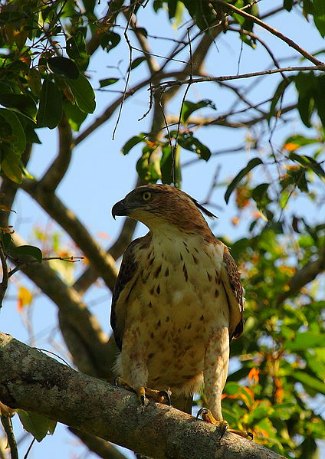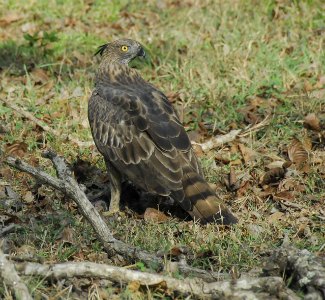Mountain Hawk Eagle - Nisaetus nipalensis
By Javahn19, CC-BY-SA-3.0, via Wikimedia Commons
Family: Accipitridae
Genus: Nisaetus
Species: N. nipalensis
Subspecies: N. n. nipalensis, N. n. orientalis (Japanese Mountain Hawk Eagle)
Mountain Hawk Eagles are large brown and white raptors that live from the Himalayan Mountains to Japan and the Russian Far East, in a range of forested habitats. They are the second-largest Asian hawk eagles. They form a clade with Nisaetus alboniger (Blyth’s Hawk Eagle), N. bartelsi (Javan Hawk Eagle), N. kelaarti (Legge’s Hawk Eagle), and N. nanus (Wallace’s Hawk Eagle), and are a sister species to N. alboniger.
Physical Description:
Mountain Hawk Eagles are brown from above with a rufous head and a black, pale-tipped crest. The belly and underwing coverts have dark brown streaks. The tail has three bands and is gray-brown from above and white below. N. n. orientalis is larger and lighter in color than the nominate subspecies and has a very small crest, unlike N. n. nipalensis.
Juveniles are dark brown with a buff- to tawny-colored underside and a barred tail. The legs are white. They reach full adult plumage after three or four years.
A shrill "klu weet weet" is uttered while perched and when in flight. Mountain Hawk Eagles are noisy during the breeding season. Listen to a recording.
Size:
Length: 67-86 cm
Wingspan: 130-165 cm
Weight: Male: 1.8-2.5 kg. Female: 3.5 kg.
Habitat and Distribution:
They occur in hill, montane, primary evergreen, mixed deciduous, and riparian forest, in addition to wooded plains. In the Himalayas they are found from 600-2,800 meters above sea level and in Yunnan Province, China, over 4,000 m. From Sri Lanka to southern India they live from 600-1,500 m and in Japan they have been recorded as low as 200 m.
Mountain Hawk Eagles inhabit a range that includes the Himalayas and east to southern China, Taiwan, Indochina, and the northern Malay Peninsula, as well as north to northeastern China, Japan, the Russian Far East, and North Korea, spanning 43°N to 6°S. They are irruptive, local, or altitudinal migrants and juveniles disperse from breeding areas. There are an estimated 10,000 individuals, but that estimate includes Nisaetus kelaarti (Legge’s Hawk Eagle), (see below Taxonomy and Subspecies) which is considered a separate species by some authorities but not by others, including BirdLife International.
By Lip Kee, CC-BY-SA-2.0, via Wikimedia Commons
Diet and Hunting:
They eat small mammals, birds, and reptiles. Hares are preferred mammalian prey and they catch a range of birds such as junglefowl, poultry, ducks, and pheasants.
They still-hunt from a perch and take their prey on the ground.
Reproduction:
Breeding displays consist of high circling and steep dives and climbs. Mountain Hawk Eagles are vocal during the breeding season, which is from December-March in Sri Lanka, February-June in the Himalayas, and April-July in Japan.
The nest is built out of sticks and can be up to 1.8 m across and 0.9-1.2 meters deep. It is placed in a tree and lined with green leaves and conifer sprigs. 1-2 eggs are laid. Exact incubation and nesting periods are unknown but are thought to total 80 days.
Conservation:
Mountain Hawk Eagles are under threat from habitat loss, but still considered common in a few parts of their range. They are currently listed as Least Concern by BirdLife International.
Taxonomy:
Nisaetus nipalensis was formerly placed in the genus Spizaetus of New World hawk eagles. However, molecular studies have shown that Asian hawk eagles are of a separate lineage than Spizaetus and were assigned the new genus Nisaetus.
By Stephen Cooper, Public domain, via Wikimedia Commons
Subspecies:
There are two subspecies: N. n. nipalensis is found in the Himalayas, southern and eastern China, Taiwan, northern Indochina, the northern Malay Peninsula, and Vietnam, and N. n. orientalis (Japanese Mountain Hawk Eagle) lives in the Russian Far East, North Korea, northeastern China, and Japan.
Nisaetus kelaarti (Legge's Hawk Eagle) used to be considered a subspecies of N. nipalensis but is treated as a full species by some authorities, based on differences in morphology, plumage, vocalization, and DNA sequences. It has also been suggested that N. n. orientalis is a separate species, but since there appears to be even less consensus over its status than there is toward the classification of N. kelaarti, N. n. orientalis is treated as a subspecies on this website.
Other Names:
Feather-Toed Hawk Eagle, Hodgson’s Hawk Eagle, Legge’s Hawk Eagle, Orel horský (Czech), Bjerghøgeørn (Danish), Aziatische kuifarend (Dutch), Mahtijalokotka (Finnish), Aigle montagnard (French), Bergadler (German), Aquilastore montano (Italian), Kumataka (Japanese), Fjellskogørn (Norwegian), Wojownik górski (Polish), Aguila-azor Montanesa (Spanish), Berghökörn (Swedish).
Video of Mountain Hawk Eagles:
References:
http://avibase.bsc-eoc.org/species.jsp?avibaseid=9EA9701E15583955
BirdLife International (2012) Species factsheet: Nisaetus nipalensis. Downloaded from http://www.birdlife.org on
20/01/2012.
Global Raptor Information Network. 2012. Species account: Mountain Hawk-eagle Nisaetus nipalensis. Downloaded from
http://www.globalraptors.org on 20 Jan. 2012
BirdLife International 2009. Nisaetus nipalensis. In: IUCN 2011. IUCN Red List of Threatened Species. Version 2011.2.
www.iucnredlist.org. Downloaded on 20 January 2012.
http://lazoo.org/animals/birds/hawkeagle_japanesemountain/index.html
http://www.planetofbirds.com/accipitriformes-accipitridae-mountain-hawk-eagle-nisaetus-nipalensis
Ferguson-Lees, James, and Christie, David A. Raptors of the World. Houghton Mifflin Company, 2001.


